linked to climate change?

DAISY DUNNE 10.03.2020 CARBONBRIEF.ORG
PHOTOS AND GRAPHS ARE HERE:
The past few months have seen locust swarms as large as entire cities sweep across countries in East Africa and surrounding regions.
With each insect able to eat its two-gram body weight in food each day, it is estimated that the swarms of billions are devouring enough crops to threaten the food supply of millions of people.
Though the region has seen locust plagues since biblical times, the scale of the current outbreak is the largest seen in 25 years in Ethiopia and Somalia – and in 70 years in Kenya.
Some media reports have pointed to a possible link between the current outbreak and climate change.
In particular, they have suggested that the plague has been worsened by recent heavy rains and unusual storm activity in the East African region. These impacts are linked to the “Indian Ocean Dipole”, a climate system that affects weather from East Africa to western Australia.
In this Q&A, Carbon Brief speaks to scientists to ask how climate change is affecting the Indian Ocean Dipole, and whether it is the climate or other factors that are behind the current locust outbreak.
Is East Africa’s current locust outbreak unprecedented?
How is the current locust outbreak linked to climate conditions?
Is climate change affecting the Indian Ocean Dipole?
What other factors are playing a role in the locust outbreak?
Will locust outbreaks become more common in East Africa in the future?
Is East Africa’s current locust outbreak unprecedented?
For months, locust plagues stretching tens of kilometres in length and breadth have blighted central and eastern Africa, the Middle East and parts of Asia, including Pakistan and India.
The swarms first arrived in the Horn of Africa at the end of summer 2019. They had moved in from the Arabian desert, where good breeding conditions in the months prior had allowed them to multiply by an astonishing 8,000-fold, according to the UN’s Food and Agricultural Organization (FAO).
In the autumn months of 2019, the insects spread further inland from Somalia and Ethiopia into countries including Kenya and Uganda. In Kenya, the FAO’s locust watch service identified one swarm that was up to 60km long and 40km wide – roughly the size of Luxembourg. The swarm was made up of up to 20bn individual locusts, officials said
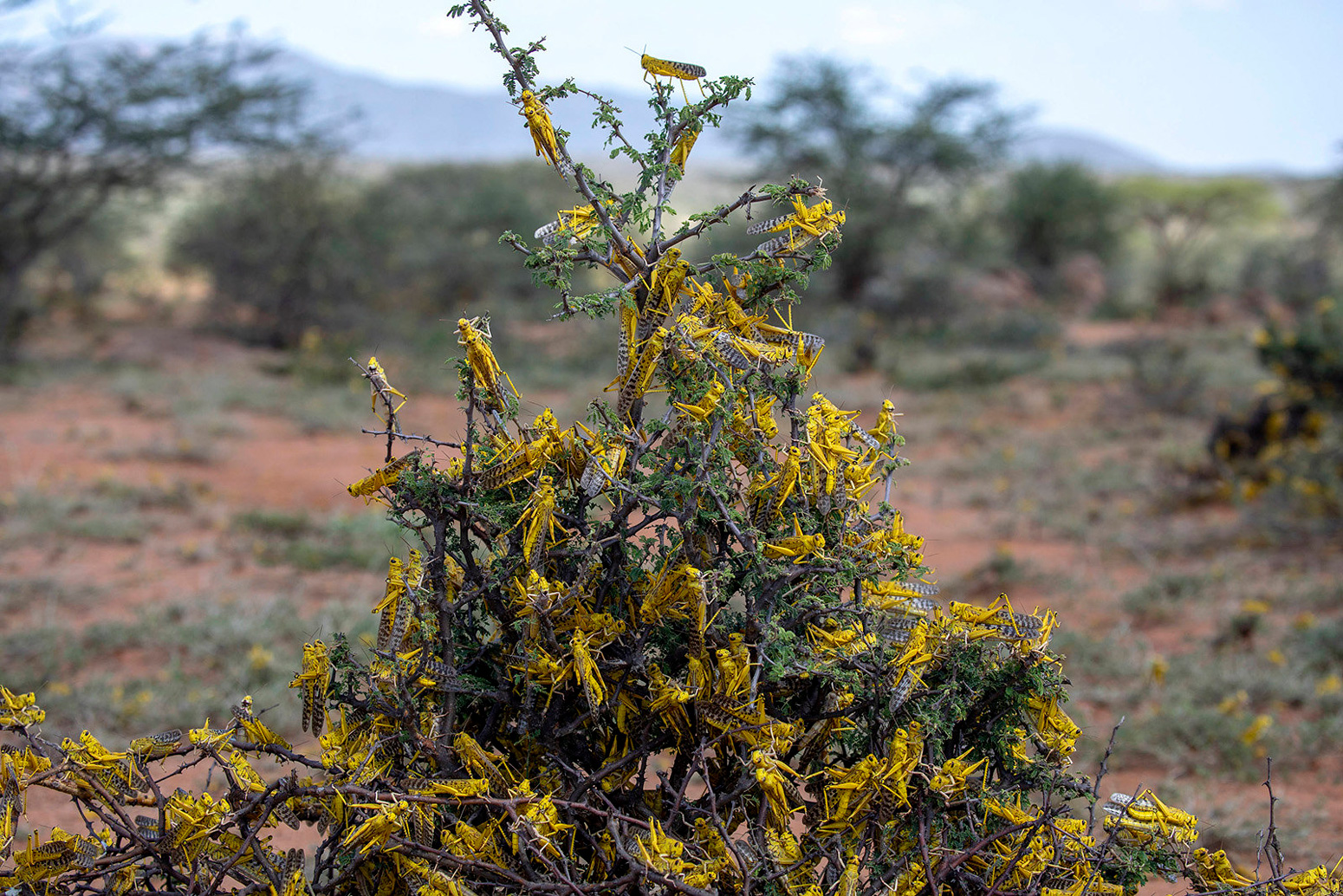 A desert locust swarm in northeastern Kenya. Credit: FAO/Sven Torfinn
A desert locust swarm in northeastern Kenya. Credit: FAO/Sven TorfinnAt the same time, locusts moved from the Arabian desert into Middle Eastern countries, such as Iran, Bahrain and Kuwait, and into parts of Asia, such as India and Pakistan.
By January and February of this year, the locusts had moved into Eritrea and threatened to spread further to Sudan, parts of the Democratic Republic of the Congo and Tanzania. China has also begun to brace itself for a possible outbreak.
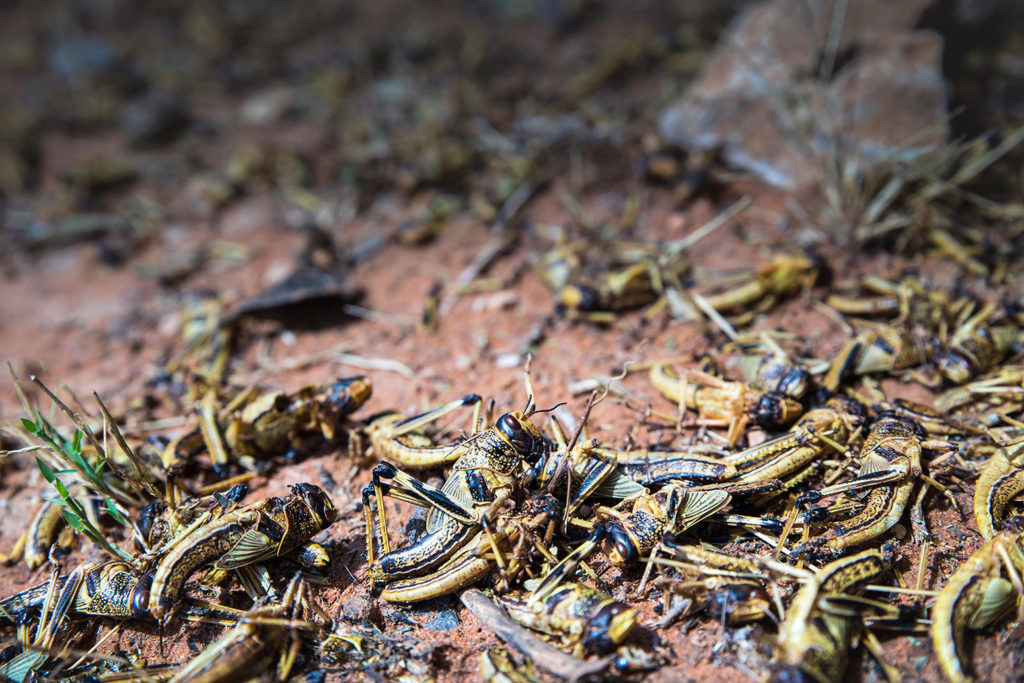 The impact of the locust invasion around Shilabo, Ogaden, Somali region in Ethiopia. Credit: FAO/Petterik Wiggers
The impact of the locust invasion around Shilabo, Ogaden, Somali region in Ethiopia. Credit: FAO/Petterik WiggersThey have devoured hundreds of kilometres of crops across East Africa, including in the Rift Valley. This could have particularly “severe consequences”, the FAO says, given the region is home to almost 12 million food-insecure people.
In Ethiopia, the swarms also caused a plane to veer off course after insects slammed into its nose, engine and windshields.
In its latest update on 2 March, the FAO’s locust watch service said the threat from locusts currently remains high in East Africa, parts of the Middle East and Pakistan.
It also warned of large increases in locust numbers in the coming months. Parts of East Africa including Kenya and Somalia could see 400-fold increases in swarm sizes by June as the insects reproduce once again.
The map below, provided by the FAO locust service, shows where insect numbers are likely to increase between March and June.
Forecast for locust swarm spread from March to June 2020. Credit: FAO Locust Watch
(UPDATE: On 14 April, the FAO Locust Watch released a further statement saying that “widespread rains…in late March are expected to cause a dramatic increase in locust numbers in East Africa, eastern Yemen and southern Iran in the coming months”. Efforts to control locust numbers have been hampered by the coronavirus outbreak, which is causing delays to pesticide deliveries across country borders, Kenyan officials told the Guardian.)
(UPDATE: The locust swarms moved further into western India from Pakistan and Iran around mid-May, according to an FAO Locust Watch update. The outbreaks in India are the worst seen in the country for 25 years, reports the New York Times.)
The FAO has estimated that the current outbreak is the largest seen in 70 years in Kenya and in 25 years in Somalia and Ethiopia. Pakistan officials say the outbreak there is the worst in 30 years.
Yearly records on the number and size locust outbreaks are not readily available for countries in East Africa, Keith Cressman, a senior locust forecasting officer at the FAO, tells Carbon Brief. This makes it difficult to establish if the current outbreak in East Africa is truly unprecedented.
The FAO does keep data on the number of countries reporting locust swarms each year globally. This is shown on the chart below, which includes the number of countries reporting locust plague “onset” (black), “peak” (purple) and “decline” (pink) from 1900-2019.
Countries report a plague “onset” when locusts are beginning to breed, plague “peak” when they have experienced heavy and widespread outbreaks for more than a year and plague decline when numbers begin to fall again, according to the FAO.
(The chart also shows the number of countries each year reporting locusts at low densities in yellow.) The number of countries reporting locust plague “onset” (black), “peak” (purple) and “decline” (pink) from 1900-2019. Chart also shows the number of countries reporting locusts at low density (yellow). Data source: FAO. Chart by Carbon Brief using Highcharts.
This chart shows that 2019 was not a record-breaking year for locust outbreaks worldwide – and that the world saw much larger plagues in the 20th century than in recent times.
However, it is worth noting that the factors driving locust swarms are largely regional – and global trends in locust outbreaks would, therefore, not be expected, scientists tell Carbon Brief. (The factors driving locust swarms are discussed in more detail below.)
How is the current locust outbreak linked to climate conditions?
Some media reports have pointed to a link between the current outbreak and unusual storm and rainfall activity around East Africa.
To understand how the cyclones and the outbreak are linked, there is a need to first understand desert-locust biology, explains Dr Philipp Lehmann, a researcher of insects and the environment from Stockholm University.
Desert locusts are “biphasic” animals, meaning they can take on two entirely different forms, says Lehmann. In their “solitary” form, they are drab brown in colour and relatively harmless to crops. But, under certain conditions, the insects can switch into a “gregarious form” – turning electric yellow and displaying swarming behaviour. Left image: Desert locust. Credit: Itsik Marom / Alamy Stock Photo.
Right image: Desert locust. Credit: FAO/Sven Torfinn.
(UPDATE: The locust swarms moved further into western India from Pakistan and Iran around mid-May, according to an FAO Locust Watch update. The outbreaks in India are the worst seen in the country for 25 years, reports the New York Times.)
The FAO has estimated that the current outbreak is the largest seen in 70 years in Kenya and in 25 years in Somalia and Ethiopia. Pakistan officials say the outbreak there is the worst in 30 years.
Yearly records on the number and size locust outbreaks are not readily available for countries in East Africa, Keith Cressman, a senior locust forecasting officer at the FAO, tells Carbon Brief. This makes it difficult to establish if the current outbreak in East Africa is truly unprecedented.
The FAO does keep data on the number of countries reporting locust swarms each year globally. This is shown on the chart below, which includes the number of countries reporting locust plague “onset” (black), “peak” (purple) and “decline” (pink) from 1900-2019.
Countries report a plague “onset” when locusts are beginning to breed, plague “peak” when they have experienced heavy and widespread outbreaks for more than a year and plague decline when numbers begin to fall again, according to the FAO.
(The chart also shows the number of countries each year reporting locusts at low densities in yellow.) The number of countries reporting locust plague “onset” (black), “peak” (purple) and “decline” (pink) from 1900-2019. Chart also shows the number of countries reporting locusts at low density (yellow). Data source: FAO. Chart by Carbon Brief using Highcharts.
This chart shows that 2019 was not a record-breaking year for locust outbreaks worldwide – and that the world saw much larger plagues in the 20th century than in recent times.
However, it is worth noting that the factors driving locust swarms are largely regional – and global trends in locust outbreaks would, therefore, not be expected, scientists tell Carbon Brief. (The factors driving locust swarms are discussed in more detail below.)
How is the current locust outbreak linked to climate conditions?
Some media reports have pointed to a link between the current outbreak and unusual storm and rainfall activity around East Africa.
To understand how the cyclones and the outbreak are linked, there is a need to first understand desert-locust biology, explains Dr Philipp Lehmann, a researcher of insects and the environment from Stockholm University.
Desert locusts are “biphasic” animals, meaning they can take on two entirely different forms, says Lehmann. In their “solitary” form, they are drab brown in colour and relatively harmless to crops. But, under certain conditions, the insects can switch into a “gregarious form” – turning electric yellow and displaying swarming behaviour. Left image: Desert locust. Credit: Itsik Marom / Alamy Stock Photo.
Right image: Desert locust. Credit: FAO/Sven Torfinn.
The Arabian Peninsula – the land mass between East Africa and Asia comprising Saudi Arabia, Yemen, Oman, Kuwait, Qatar, Bahrain and the United Arab Emirates – was struck by several unusually severe cyclones between 2018 and 2019.
When the first storm – Cyclone Mekunu – hit the Arab peninsula in May 2018, it filled a vast desert near Yemen and Oman, known as the Empty Quarter, with freshwater lakes.
The moisture caused lush vegetation to grow in the usually barren environment, attracting desert locusts hunting for food into the area, Lehmann tells Carbon Brief. “The first cyclone lead to this emergence of optimal breeding grounds for the locusts.”
Desert locusts only switch to a gregarious form when they reach high enough numbers in a certain area, explains Dr Cyril Piou, a locusts researcher at France’s Agricultural Research for Development Centre (CIRAD). He tells Carbon Brief:
“Once they reach a certain density, they start to touch each other a lot and this triggers them to change their behaviour.”
When the first storm – Cyclone Mekunu – hit the Arab peninsula in May 2018, it filled a vast desert near Yemen and Oman, known as the Empty Quarter, with freshwater lakes.
The moisture caused lush vegetation to grow in the usually barren environment, attracting desert locusts hunting for food into the area, Lehmann tells Carbon Brief. “The first cyclone lead to this emergence of optimal breeding grounds for the locusts.”
Desert locusts only switch to a gregarious form when they reach high enough numbers in a certain area, explains Dr Cyril Piou, a locusts researcher at France’s Agricultural Research for Development Centre (CIRAD). He tells Carbon Brief:
“Once they reach a certain density, they start to touch each other a lot and this triggers them to change their behaviour.”
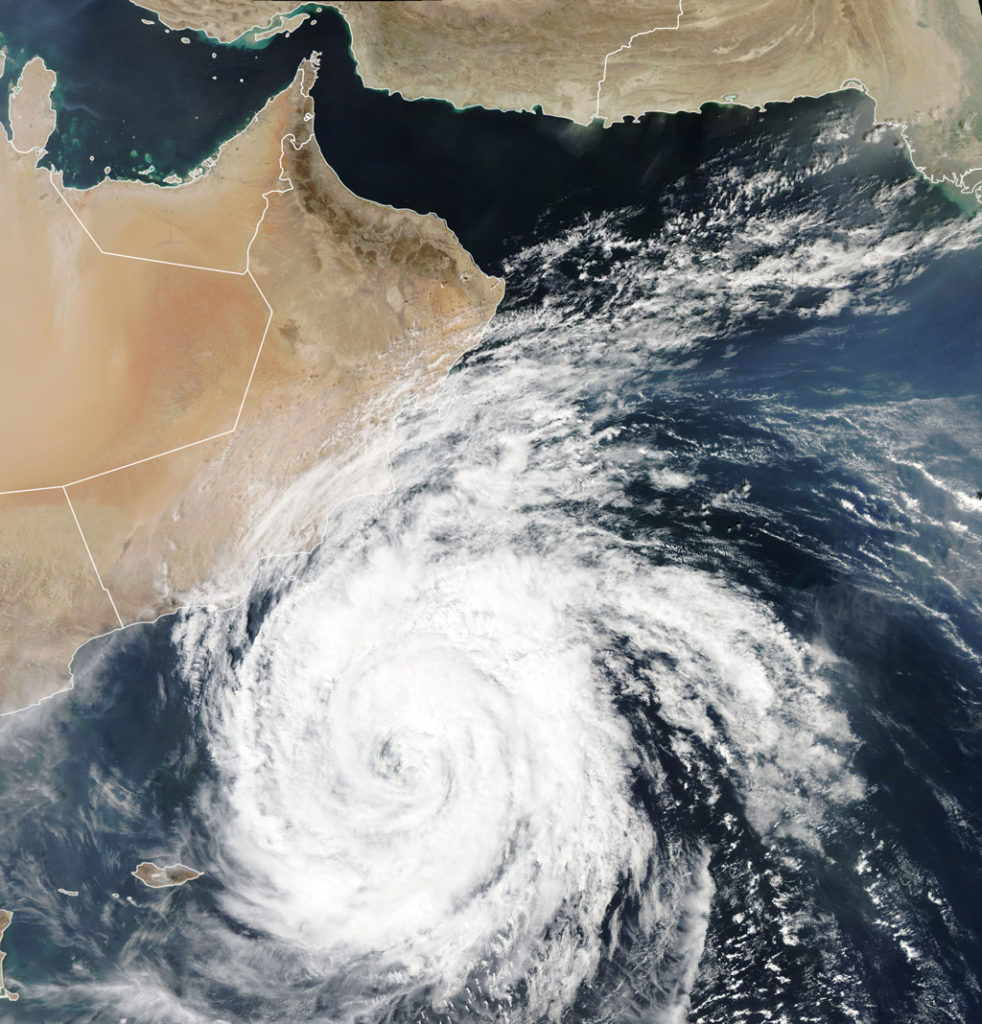 Satellite image of Cyclone Luban close to the Arab peninsula on 11 October, 2018. Credit: NASA Earth Observatory/Lauren Dauphin
Satellite image of Cyclone Luban close to the Arab peninsula on 11 October, 2018. Credit: NASA Earth Observatory/Lauren DauphinBy the time that the second storm – Cyclone Luban – arrived in the same region in October, the locusts had just hit a critical point where they had started to multiply rapidly, says Lehmann:
“It was actually the second cyclone that was the big problem because the locusts were at a point where they had the ability optimise their reproductive capacity to produce a new front of migrating locusts.”
Spurred on by the ample food supply provided by the cyclones’ rains, the locusts multiplied rapidly – increasing their numbers 8,000-fold in just a few months.
The unusually rainy period was then followed by a particularly mild winter, which allowed the locusts to survive in large numbers, says Lehmann.
Then, in the summer of 2019, the insects began to migrate from the Arab peninsula into the horn of Africa.
As the insects moved through East Africa, the region was hit by unusually wet conditions and more cyclones – allowing the swarms to grow even larger, says Lehmann.
Across the Horn of Africa, rainfall between October and mid-November was 300% above average. In Kenya, rainfall was up to 400% higher than average. Overall, the Horn of Africa was hit by eight cyclones in 2019, the largest number in any year since 1976.
As well as providing the conditions needed for vegetation growth, cyclones could also worsen outbreaks by providing winds for the locusts to hitch a ride on, says Lehmann:
“Winds can definitely push insects in great numbers over great distances – and at quite a small energetic cost, meaning that they have more energy available for reproduction.”
The unusual wet weather in East Africa is linked to a wider climate system known as the Indian Ocean Dipole (IOD). The dipole affects weather on both sides of the ocean, from East Africa and the Arab Peninsula to Indonesia, Papua New Guinea and Australia. (The IOD also sometimes referred to as the “Indian Niño” because of its similarities to El Niño in the Pacific.)
The dipole, which was formally identified in 1999, has three phases – positive, negative and neutral. Events typically develop in the northern hemisphere summer, peak in the autumn and then decline rapidly in winter. However, events can also stay put for extended periods.
In a neutral dipole phase, waters around Indonesia, Papua New Guinea and Australia are warm, which causes air to rise up and fall as rain. Winds blow in a westerly direction. In this phase, the dipole has very little effect on temperatures in countries surrounding the Indian Ocean. The diagram below illustrates what occurs in a neutral phase.
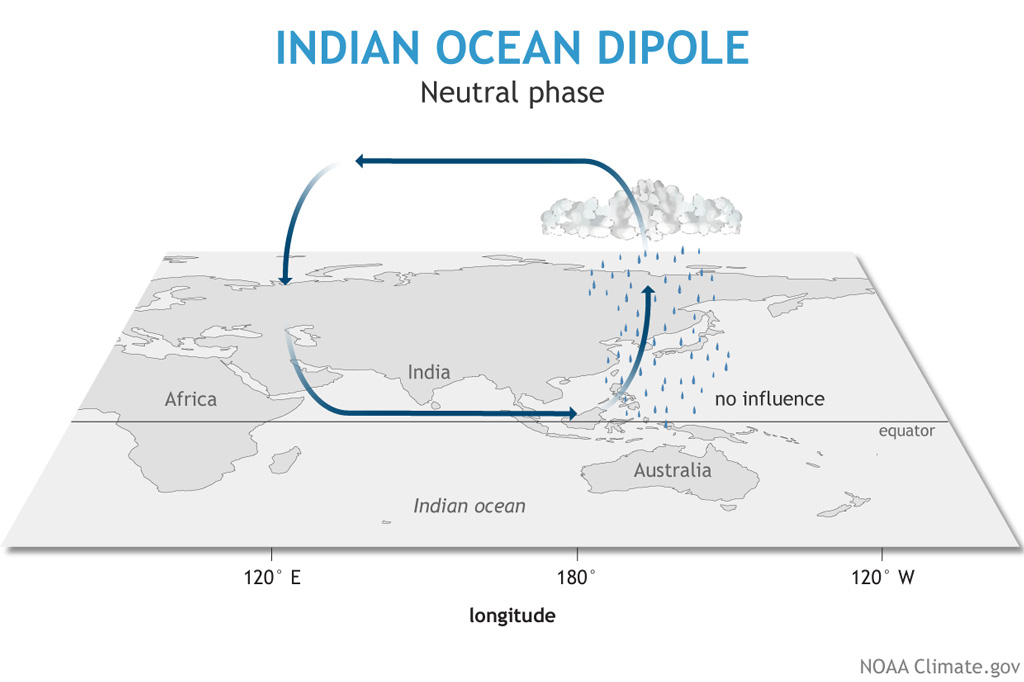 Diagram showing the impacts of a neutral Indian Ocean Dipole phase. Credit: NOAA
Diagram showing the impacts of a neutral Indian Ocean Dipole phase. Credit: NOAADuring a positive phase, however, this pattern reverses. Westerly winds weaken and, sometimes, easterly winds form – dragging warm water towards the Arab Peninsula and the Horn of Africa.
This, in turn, plays a role in driving cyclones and heavy rainfall in the region. Cyclone frequency increases during a positive dipole phase because the additional warmth and moisture brought by the climate system acts as fuel for budding storms. The diagram below illustrates the impacts of a positive IOD phase.
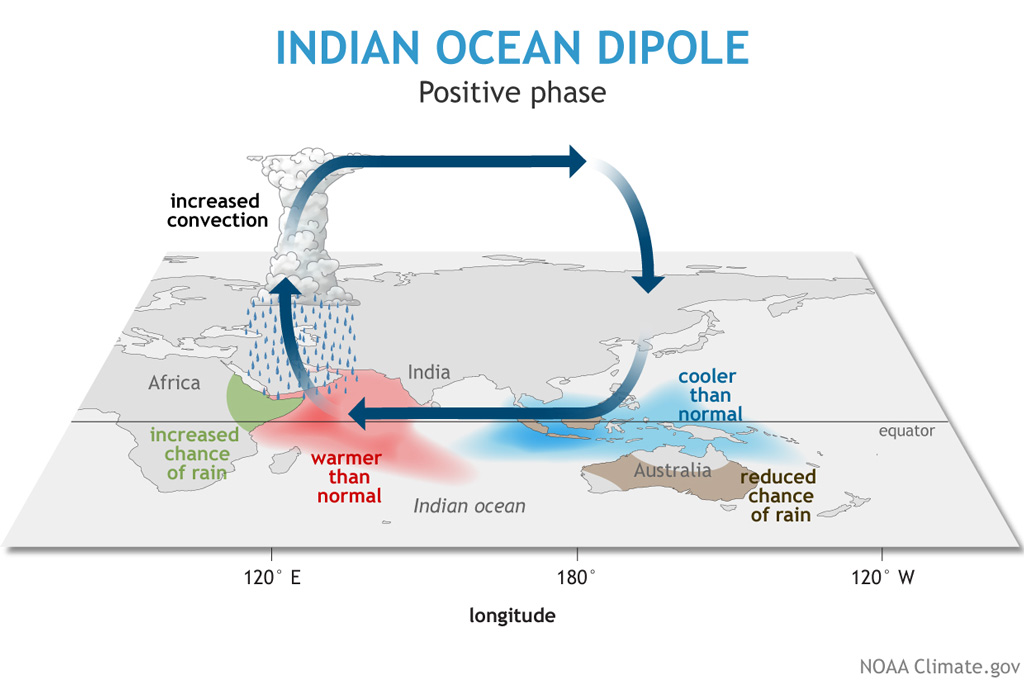 Diagram showing the impacts of a positive Indian Ocean Dipole phase. Credit: NOAA
Diagram showing the impacts of a positive Indian Ocean Dipole phase. Credit: NOAAThe IOD was in positive phase in the June to December period of both 2018 and 2019. In 2019, the dipole reached its most extreme positive level in 40 years.
As well as driving rains in East Africa, the strongly positive dipole also played a role in driving Australia’s unprecedented 2019-2020 bushfires. This is because rains shifted towards East Africa, leaving Australia with drought-like conditions.
(A recent analysis by the World Weather Attribution initiative found the conditions for fire in Australia were made “much more severe” by the positive dipole phase.)
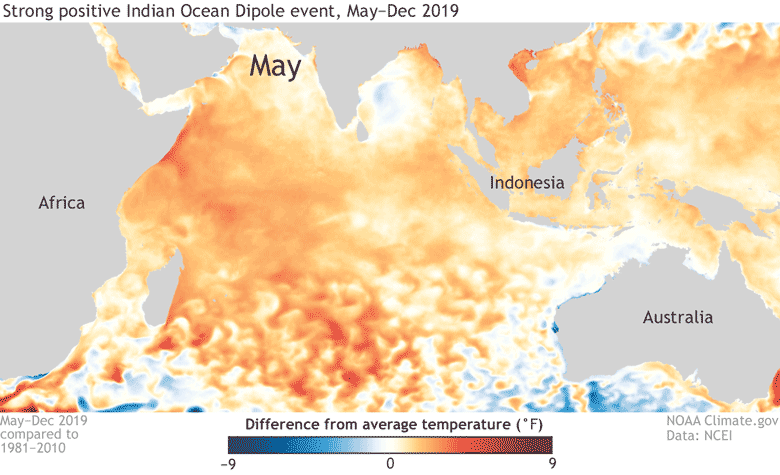
Is climate change affecting the Indian Ocean Dipole?
Some people have suggested that the extreme wet weather seen during the 2018 and 2019 dipoles could be linked to climate change.
António Guterres, the UN’s secretary general, recently said in a statement:
“There is a link between climate change and the unprecedented locust crisis plaguing Ethiopia and East Africa. Warmer seas mean more cyclones generating the perfect breeding ground for locusts. This is getting worse by the day.”
The extreme positive dipole in 2019 certainly does fit into a picture of long-term change, says Dr Wenju Cai, director of the Centre for Southern Hemisphere Oceans Research at the Commonwealth Scientific and Industrial Research Organisation (CSIRO) in Australia. He tells Carbon Brief:
“It’s highly likely that the event that we’ve just seen has a very strong warming component in it – but attributing individual events to long-term climate change is not a simple issue.”
To understand how the dipole is changing, scientists study something known as the “dipole mode index” – which is the difference between average sea-surface temperatures in the western Indian Ocean and the eastern Indian Ocean, explains Cai.
During a positive phase, temperatures in the western Indian Ocean are higher than in the eastern Indian Ocean – giving an overall positive index. The chart below shows how the monthly dipole mode index changed from January 1979 to December 2019.
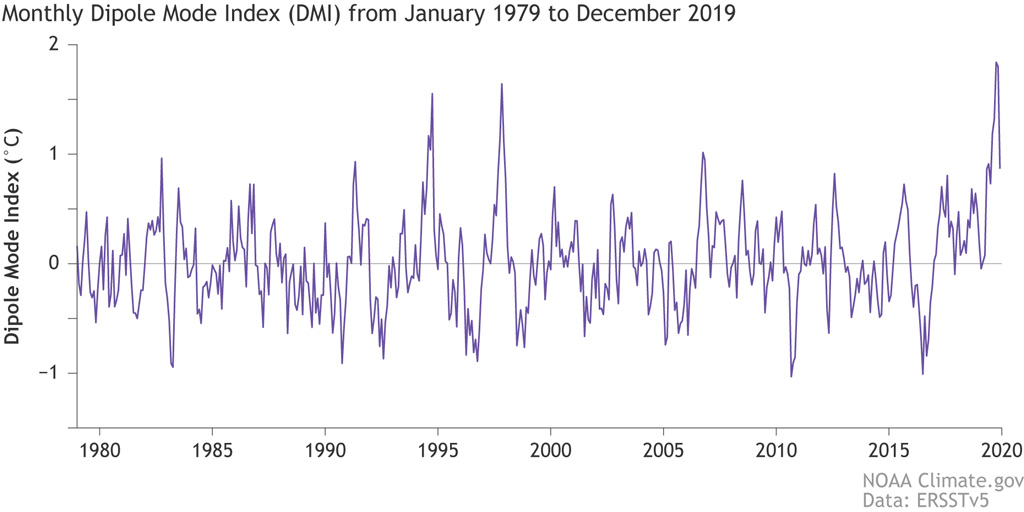 Monthly Indian Ocean Dipole mode index from January 1979 to December 2019. Credit: NOAA
Monthly Indian Ocean Dipole mode index from January 1979 to December 2019. Credit: NOAAThe chart shows how the mode index reached its highest recorded level in the northern hemisphere winter of 2019, the time when East Africa was hit by heavy rains and unusual cyclone activity.
The dipole was also positive in 2018, when the Arab peninsula was struck by several cyclones – though this dipole was less extreme, Cai says.
Looking back over longer timescales, it is clear that the dipole mode index has been “rising up steadily”, he adds:
“There is always a role for natural variability, but we think this is due, in a large part, to climate change because this persistent trend of 60-70 years is not fully consistent with, for example, decadal variability, which would have gone up and down over a 70-year period.”
A 2009 study led by Cai found that positive phases of the dipole have increased in frequency since the 20th century. In the early 20th century, a positive dipole phase occurred roughly four times in a 30-year period. However, in the 30-year period spanning 1989-2009, there were 10 positive dipoles.
A study published this week in Nature reinforced the finding that positive dipole events are becoming more frequent. It looked at ancient coral records stretching back to 1240 and found that positive dipole events that were once rare in the ancient world and now commonplace.
Climate change could be skewing the dipole in favour of positive phases because the western Indian Ocean – near Africa – is warming at a faster rate than the eastern Indian Ocean, Cai explains:
“With the western Indian Ocean warming faster, it’s easier for the temperature difference between the west and the east to become very large. And, so, it’s much easier to have the rising air that brings rain happening in the western part of the Indian Ocean.”
Further analysis by Cai and colleagues found that uncontrolled future climate change could cause positive dipole events to increase by a factor of three by 2099, when compared to the period 1900-1999.
INCIDENT / Ethiopian Airlines B737-700 (ET-ALN, built 2005) encountered a grasshoppers swarm on approach to Dire Dawa Airport. The pilots discontinued the approach and flight #ET363 diverted safely to Addis Ababa.
via www.onthewingsaviation.com/…/un-b737-de-ethiopian-airlines-…
Even if global temperature rise is limited to 1.5C – the aspirational target set by the Paris Agreement – the number of positive dipole events could double, when compared to the pre-industrial era, according to another study.
Such increases are likely to bring about more frequent and intense cyclones, says Dr Agus Sontoso, a senior research associate at the Climate Change Research Centre at the University of New South Wales in Sydney. He tells Carbon Brief:
“The Indian Ocean itself is warming everywhere. So it’s reasonable to think that under climate change, we expect to see more frequent, if not stronger, cyclones in the region.”
What other factors are playing a role in the current locust outbreak?
Though the rainy weather played a role in driving the current locust outbreak, there are several factors that could have contributed to the insects’ spread, scientists tell Carbon Brief.
One major factor is that countries did not act quickly enough to prevent the locusts from spreading in 2018, says Piou:
“This specific crisis is also due to the fact there was no preventative management in many of the places where the rain fell. Saying it’s directly linked to climate change is too simple – it’s forgetting that we should have been preventing the outbreak in the first place.”
According to the FAO, the best way to stop locusts from spreading is to spray small concentrated areas with pesticides. This is most effective early on in an outbreak, when the insects are still multiplying, says Piou.
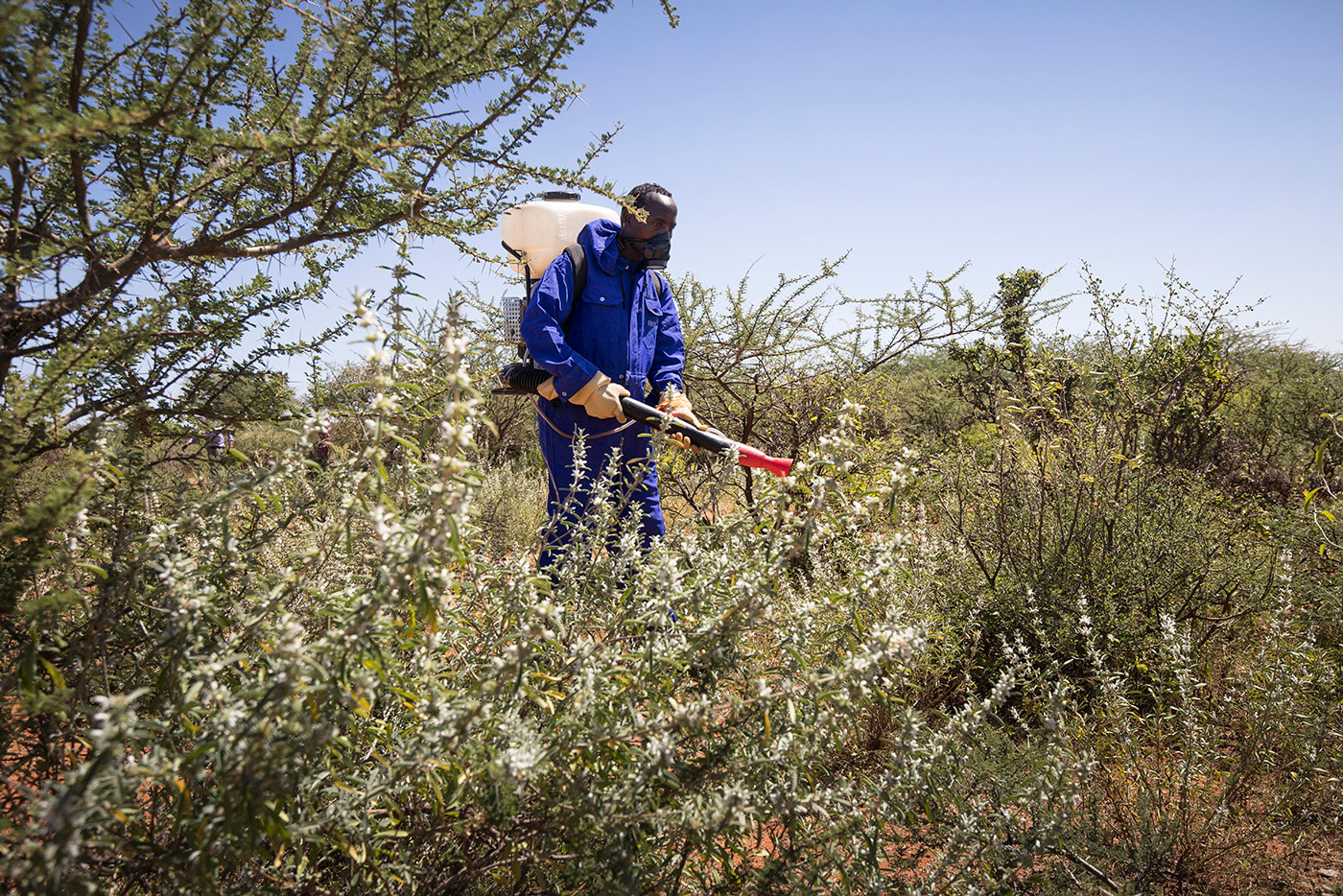 A government staff member of the Ethiopian ministry of Agriculture spraying against locusts in the Somali region of Ethiopia. Credit: FAO/Petterik Wiggers
A government staff member of the Ethiopian ministry of Agriculture spraying against locusts in the Somali region of Ethiopia. Credit: FAO/Petterik WiggersThe responsibility of controlling locust numbers falls to national governments – with international organisations stepping in during outbreak and crisis situations.
The insects first started to multiply in the south of the Arab peninsula, a region experiencing political instability and conflict. This may have thwarted early detection and prevention methods, says Lehmann:
“There’s actually some studies on this – though not in an African context. I’ve worked a lot with the Colorado potato beetle, which arrived in Europe during the first world war. Before the war, it was contained by early prevention efforts. During the first world war, people had other things on their mind – the potato beetle arrived, established itself and started spreading. Then, during the interwar period of the 20s and 30s, the spread was quite contained. But during the second world war, there was the biggest spread that we’ve ever seen.”
It is worth noting that other parts of Africa, including Niger and Mauritania, periodically experience heavy rains, but do not see outbreaks on the same scale, says Piou:
“The prevention system is working in some other parts of the world. For example, in western Africa, they experience heavy rains that arrive and create some good conditions for the desert locust to breed and multiply – but they don’t see such large outbreaks.”
Another possible driver influencing the current outbreak could be an increase in irrigated agriculture in parts of East Africa, says Lehmann:
“People live year-round in these semi-arid areas and you need irrigation in order to maintain crops. This also creates stopping points for a swarm.”
Overall, it is likely that several factors worked in tandem to make the current outbreak so extreme, says Lehmann:
“I think there can be several reasons for why an outbreak starts and, in many ways, it’s like the stars have to align – and, when they do, something very bad happens.”
Will locust outbreaks become more common in East Africa in the future?
Though studies suggest that the wet conditions seen in Africa during the winter 2019 are likely to become more frequent with climate change, it is less clear if there will be a corresponding increase in locust outbreaks, scientists tell Carbon Brief.
This is because many factors influence the chance of an outbreak, including human factors such as taking early preventative measures, says Piou:
“If there are more cyclones in the Arab peninsula, then eventually, yes, there could be more outbreaks. But still, in any case, the main message should be to be prepared for that with a preventative system.”
It is likely that locust outbreaks will “stay bad” in East Africa, says Lehmann:
“I think they will stay bad – as they are. I base this simply on the fact that locusts are cyclic and there have been outbreaks for thousands of years. If they return, I think there can be several reasons for why an outbreak starts.”
The “jury is still out” on how future temperature rise in the East African region could affect outbreaks, he adds.
(According to Carbon Brief analysis, temperatures around the horn of Africa could increase 1.6-4.6C by 2100, depending on the rate of future greenhouse gas emissions.)
Research suggests that desert locusts do prefer hotter temperatures, says Piou:
“The perfect temperature for a desert locust to multiply is around 35C during the day. And even below this temperature, they display warming up behaviours to reach a body temperature of 40C, which is the optimal temperature for their metabolism.”
However, despite hotter temperatures giving the insects a physiological advantage, it is not yet clear if this would influence their swarming behaviour, says Lehmann.
Overall, climate change is expected to make weather conditions in East Africa less predictable – which is likely to benefit insect pests, he adds:
“I don’t know if it’s the locusts, per se, or some other pests that will respond – but insect pests generally thrive in unpredictable environments.”
Locust plagues point to grim future of climate change
Climatic changes in China, the Middle East and Africa could see more severe outbreaks of locusts devastating food crops
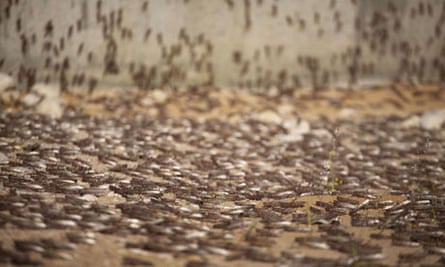
Thu 23 May 2013
The desert locust, the most notorious of about a dozen locust species for its ability to rapidly multiply and travel long distances, threatens an area of 32 million square kilometres, stretching across 50 countries from west Africa to India.
The fearsome insect has been farmers' foe since the earliest days of agriculture.
When solitary, locusts are harmless. But when they congregate into groups they transform – in behaviour and even appearance – into killer vegetarians. In turn, swarms can be as large as several hundred square kilometres, of which a single square kilometre can comprise at least 40 million bugs, at times even double that.
In the immature adult phase, a locust can consume its own weight – about two grams – in vegetation per day, according to the UN's Food and Agriculture Organization (FAO). One tonne of desert locusts ("a very small part of an average swarm", according to FAO's website) could guzzle in a single day an amount of food equivalent to that consumed by 2,500 people. Locust plagues could therefore seriously imperil crop production, and in turn food security.
An ongoing desert locust upsurge, primarily along the Red Sea periphery, possibly acts as a reminder to a natural threat that is often overlooked, or even deemed a thing of the past.
Swarms of locusts spread from North Africa
Countries today are considerably better equipped to deal with the threat than they used to be. The second half of the twentieth century has seen a dramatic decline in frequency, duration and intensity of desert locust plagues, largely thanks to improved control and monitoring capacities in the affected countries.
"What we have done as a big improvement is to be able to monitor where the locust are and try to control them," says Pietro Ceccato, an environmental remote sensing expert with the International Research Institute for Climate and Society (IRI) at Columbia University. "Now we have that information – both from the control teams and from the satellite. We know where to target the control."
And yet, in anticipating future locust invasions, climate change appears to be one key unknown.
"This year is a bit unusual," says Keith Cressman, senior locust forecasting officer at FAO. Normally, he explains, after a good breeding season like this year's, the locusts would move from Sudan to the interior of the Arabian Peninsula, across the Red Sea. This autumn, however, while some did reach Saudi Arabia, groups started migrating northwards to the interior of Sudan and further to Egypt, not before Sudanese authorities treated close to 270 square kilometres.
By late February, an outbreak looked imminent, as groups and swarms of a new locust generation started moving north. In early March, Egyptian news outlets and social media were teeming with reports and photos of the clouds of locust that had descended on Cairo.
"It is relatively rare that Desert Locust swarms reach Cairo," the website of FAO's locust unit later reported. "This last occurred in November 2004, almost 50 years to the day after the previous occasion."
Within days, the swarms flying further east crossed the border into Israel, reaching the north west of the Negev desert. Three weeks later Jewish Israelis were celebrating Passover, commemorating the exodus of the Israelites from ancient Egypt, preceded by the Ten Plagues, the eight of which was the Plague of Locust.
According to FAO's Locust Watch, April has seen a total of 220 square kilometres treated across five countries, down from 790 square kilometres in March.
In Israel, the ministry of agriculture reported in mid-May that damages to crops were "minimal," but concerns are of the next waves of locust coming in from Egypt's Sinai peninsula as well as a new generation of the pest after extensive hatching has been detected.
"[Israeli] researchers had said that [the locusts] would not even be able to breed here due to weather conditions. And not only did they manage to breed, they have bred excellently and even settled. So, all projections were disproved," Dafna Yurista, the ministry's spokesperson told chinadialogue. According to FAO, the last time Israel saw locust breeding and formation of hopper bands was in April 1961.
Nevertheless, and despite the ongoing outbreak, control operations across the region appear to have been effective. "So far, there hasn't been any significant damage to crops," says FAO's Cressman.
In Locust Watch's latest update, from May 15, three countries were put on the second highest level of alert – Saudi Arabia, Israel and Sudan – and control teams have been operating to curb the infestations before the young hoppers become voracious adults by the end of the month.
Adult locust groups forming in these countries are expected to move back to the summer breeding areas in central Sudan. In addition, some locusts now in Saudi Arabia, the Locust Watch update stated, "could reach southwest Iran and continue moving eastwards."
"So far," Cressman says, "Sudan, Egypt, Saudi Arabia have been lucky. What we're concerned about now is this coming month in Sudan, where we have a new generation of locust, and those immature adults more likely to stay in those cropping areas and eat whatever is green – basically, the seasonal crops."
The last time the region had faced a large-scale locust upsurge was in 2003-2005. Back then, swarms took off from Niger and moved up to north Africa, before heading east along the Mediterranean coast. Overall, 26 countries were affected, and nearly 130,000 square kilometres were treated.
Back then, Morocco alone treated 40,000 square kilometres over a two-year period, escaping the plague without any substantial damage, says FAO's locust expert in the country Said Ghaout. This time, Morocco has seen a considerably smaller extent of infestation.
The impact of climate change
Yet both outbreaks have shown anomalous patterns, mostly owing to unusually favorable weather conditions at the locusts' breeding areas. Ghaout does not rule out the possibility that climate change played a role, or that these outbreaks might be a sign of things to come. "This is a question everybody is asking," he says.
"It's a real difficult topic," says Cressman about the possible effect of climate change on the desert locust. Generally, global meteorological models aren't sufficiently reliable to make concrete predictions for the desert locust habitat range, and regional models for the relevant desert areas are not developed enough, he says.
Overall, forecasts for desert locust activity rely on four main factors: temperature, rainfall, vegetation and wind. "I took a look at all the data that we have so far, and looked at temperature – because that's what everyone kind of agrees on, and we have the most data on – and it seems like if there's an increase of temperature under climate change scenarios, the effect on desert locust is very minimal," says Cressman. In this case, "they might be able to get an extra generation of breeding in before the habitat becomes unfavorable."
It's not all about temperature, however. To breed, desert locusts require moist soil and vegetation, so precipitation is key. But climate change models for the region contradict one another when it comes to rainfall, says Cressman.
For instance, in late April and early May, Saudi Arabia saw more rainfall than usual, which could in turn contribute to locusts moving further into the interior of the Arabian peninsula. "It happens that sometimes you have more rain, sometimes you have less rain," says IRI's Ceccato, who monitors climatic and ecological conditions that affect desert locust activity. "But that happens. It's variability. To relate that to climate change, it's difficult."
China's locust plagues
Several studies have tried to explore the possible impact of climate change on the abundance of another species, the Oriental migratory locust, in China. In 2011, researchers examined locust outbreaks recorded over a period of 1,910 years and meteorological data over the same time-span and concluded, that "there were more locusts under dry and cold conditions and when abundance was high in the preceding year or decade." Therefore, an increase in temperature or rainfall would actually mean fewer locust outbreaks.
A paper published four years earlier, based on a thousand years of records, has also suggested that warming could mean fewer locust plagues in China, since locust numbers were historically "highest during cold and wet periods".
Yet, a 2009 study using the same data came to different conclusions. Climate change, these authors said, could worsen locust outbreaks in China. Taking a more geographically nuanced approach, the researchers showed that, in north China, the most severe locust upsurges happened in warm and dry years. In south China, however, it was during warm and wet years.
Despite their contradictions, taken together these studies and others do offer some valuable insights, and not only for China. First, scientists seem to agree that rainfall could be affecting locust dynamics more than temperature. There also appears to be a consensus that climate change predictions for rainfall patterns are so far unsatisfactory.
And this is not the only missing variable. "The other aspect that nobody is really looking at yet is what's going to happen to the wind under climate change," Cressman says, "because of course locusts migrate with the wind."
Even if projections are still inconclusive, history tells us that locusts have braved previous climatic changes, and humans need to prepare.
"Probably all countries need to review their preparedness in terms of some of these climate change scenarios, and maybe look at the worst case scenario," says FAO's Cressman. In particular, that means preparing for longer locust seasons, he explains. "They're going to have to make those plans a little more flexible."
Topics
Insects
Guardian Environment Network
Climatic changes in China, the Middle East and Africa could see more severe outbreaks of locusts devastating food crops

Locusts swarm in the Israeli village of Kmehin. Photograph: Menahem Kahana/AFP/Getty Images
By Ido Liven for ChinaDialogue, part of the Guardian Environment Network
By Ido Liven for ChinaDialogue, part of the Guardian Environment Network
Thu 23 May 2013
The desert locust, the most notorious of about a dozen locust species for its ability to rapidly multiply and travel long distances, threatens an area of 32 million square kilometres, stretching across 50 countries from west Africa to India.
The fearsome insect has been farmers' foe since the earliest days of agriculture.
When solitary, locusts are harmless. But when they congregate into groups they transform – in behaviour and even appearance – into killer vegetarians. In turn, swarms can be as large as several hundred square kilometres, of which a single square kilometre can comprise at least 40 million bugs, at times even double that.
In the immature adult phase, a locust can consume its own weight – about two grams – in vegetation per day, according to the UN's Food and Agriculture Organization (FAO). One tonne of desert locusts ("a very small part of an average swarm", according to FAO's website) could guzzle in a single day an amount of food equivalent to that consumed by 2,500 people. Locust plagues could therefore seriously imperil crop production, and in turn food security.
An ongoing desert locust upsurge, primarily along the Red Sea periphery, possibly acts as a reminder to a natural threat that is often overlooked, or even deemed a thing of the past.
Swarms of locusts spread from North Africa
Countries today are considerably better equipped to deal with the threat than they used to be. The second half of the twentieth century has seen a dramatic decline in frequency, duration and intensity of desert locust plagues, largely thanks to improved control and monitoring capacities in the affected countries.
"What we have done as a big improvement is to be able to monitor where the locust are and try to control them," says Pietro Ceccato, an environmental remote sensing expert with the International Research Institute for Climate and Society (IRI) at Columbia University. "Now we have that information – both from the control teams and from the satellite. We know where to target the control."
And yet, in anticipating future locust invasions, climate change appears to be one key unknown.
"This year is a bit unusual," says Keith Cressman, senior locust forecasting officer at FAO. Normally, he explains, after a good breeding season like this year's, the locusts would move from Sudan to the interior of the Arabian Peninsula, across the Red Sea. This autumn, however, while some did reach Saudi Arabia, groups started migrating northwards to the interior of Sudan and further to Egypt, not before Sudanese authorities treated close to 270 square kilometres.
By late February, an outbreak looked imminent, as groups and swarms of a new locust generation started moving north. In early March, Egyptian news outlets and social media were teeming with reports and photos of the clouds of locust that had descended on Cairo.
"It is relatively rare that Desert Locust swarms reach Cairo," the website of FAO's locust unit later reported. "This last occurred in November 2004, almost 50 years to the day after the previous occasion."
Within days, the swarms flying further east crossed the border into Israel, reaching the north west of the Negev desert. Three weeks later Jewish Israelis were celebrating Passover, commemorating the exodus of the Israelites from ancient Egypt, preceded by the Ten Plagues, the eight of which was the Plague of Locust.
According to FAO's Locust Watch, April has seen a total of 220 square kilometres treated across five countries, down from 790 square kilometres in March.
In Israel, the ministry of agriculture reported in mid-May that damages to crops were "minimal," but concerns are of the next waves of locust coming in from Egypt's Sinai peninsula as well as a new generation of the pest after extensive hatching has been detected.
"[Israeli] researchers had said that [the locusts] would not even be able to breed here due to weather conditions. And not only did they manage to breed, they have bred excellently and even settled. So, all projections were disproved," Dafna Yurista, the ministry's spokesperson told chinadialogue. According to FAO, the last time Israel saw locust breeding and formation of hopper bands was in April 1961.
Nevertheless, and despite the ongoing outbreak, control operations across the region appear to have been effective. "So far, there hasn't been any significant damage to crops," says FAO's Cressman.
In Locust Watch's latest update, from May 15, three countries were put on the second highest level of alert – Saudi Arabia, Israel and Sudan – and control teams have been operating to curb the infestations before the young hoppers become voracious adults by the end of the month.
Adult locust groups forming in these countries are expected to move back to the summer breeding areas in central Sudan. In addition, some locusts now in Saudi Arabia, the Locust Watch update stated, "could reach southwest Iran and continue moving eastwards."
"So far," Cressman says, "Sudan, Egypt, Saudi Arabia have been lucky. What we're concerned about now is this coming month in Sudan, where we have a new generation of locust, and those immature adults more likely to stay in those cropping areas and eat whatever is green – basically, the seasonal crops."
The last time the region had faced a large-scale locust upsurge was in 2003-2005. Back then, swarms took off from Niger and moved up to north Africa, before heading east along the Mediterranean coast. Overall, 26 countries were affected, and nearly 130,000 square kilometres were treated.
Back then, Morocco alone treated 40,000 square kilometres over a two-year period, escaping the plague without any substantial damage, says FAO's locust expert in the country Said Ghaout. This time, Morocco has seen a considerably smaller extent of infestation.
The impact of climate change
Yet both outbreaks have shown anomalous patterns, mostly owing to unusually favorable weather conditions at the locusts' breeding areas. Ghaout does not rule out the possibility that climate change played a role, or that these outbreaks might be a sign of things to come. "This is a question everybody is asking," he says.
"It's a real difficult topic," says Cressman about the possible effect of climate change on the desert locust. Generally, global meteorological models aren't sufficiently reliable to make concrete predictions for the desert locust habitat range, and regional models for the relevant desert areas are not developed enough, he says.
Overall, forecasts for desert locust activity rely on four main factors: temperature, rainfall, vegetation and wind. "I took a look at all the data that we have so far, and looked at temperature – because that's what everyone kind of agrees on, and we have the most data on – and it seems like if there's an increase of temperature under climate change scenarios, the effect on desert locust is very minimal," says Cressman. In this case, "they might be able to get an extra generation of breeding in before the habitat becomes unfavorable."
It's not all about temperature, however. To breed, desert locusts require moist soil and vegetation, so precipitation is key. But climate change models for the region contradict one another when it comes to rainfall, says Cressman.
For instance, in late April and early May, Saudi Arabia saw more rainfall than usual, which could in turn contribute to locusts moving further into the interior of the Arabian peninsula. "It happens that sometimes you have more rain, sometimes you have less rain," says IRI's Ceccato, who monitors climatic and ecological conditions that affect desert locust activity. "But that happens. It's variability. To relate that to climate change, it's difficult."
China's locust plagues
Several studies have tried to explore the possible impact of climate change on the abundance of another species, the Oriental migratory locust, in China. In 2011, researchers examined locust outbreaks recorded over a period of 1,910 years and meteorological data over the same time-span and concluded, that "there were more locusts under dry and cold conditions and when abundance was high in the preceding year or decade." Therefore, an increase in temperature or rainfall would actually mean fewer locust outbreaks.
A paper published four years earlier, based on a thousand years of records, has also suggested that warming could mean fewer locust plagues in China, since locust numbers were historically "highest during cold and wet periods".
Yet, a 2009 study using the same data came to different conclusions. Climate change, these authors said, could worsen locust outbreaks in China. Taking a more geographically nuanced approach, the researchers showed that, in north China, the most severe locust upsurges happened in warm and dry years. In south China, however, it was during warm and wet years.
Despite their contradictions, taken together these studies and others do offer some valuable insights, and not only for China. First, scientists seem to agree that rainfall could be affecting locust dynamics more than temperature. There also appears to be a consensus that climate change predictions for rainfall patterns are so far unsatisfactory.
And this is not the only missing variable. "The other aspect that nobody is really looking at yet is what's going to happen to the wind under climate change," Cressman says, "because of course locusts migrate with the wind."
Even if projections are still inconclusive, history tells us that locusts have braved previous climatic changes, and humans need to prepare.
"Probably all countries need to review their preparedness in terms of some of these climate change scenarios, and maybe look at the worst case scenario," says FAO's Cressman. In particular, that means preparing for longer locust seasons, he explains. "They're going to have to make those plans a little more flexible."
Topics
Insects
Guardian Environment Network







No comments:
Post a Comment